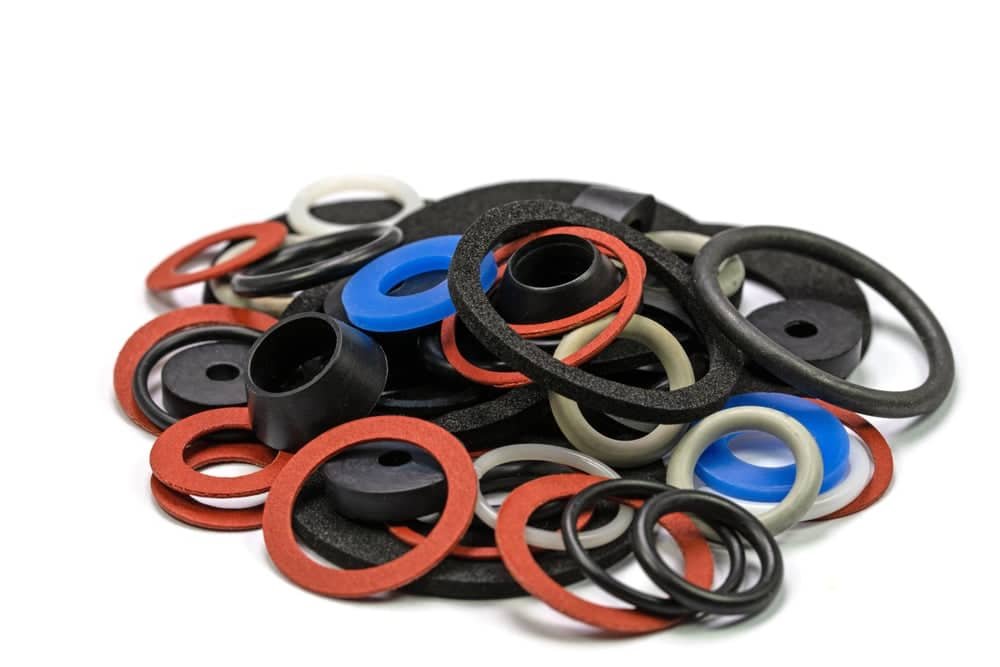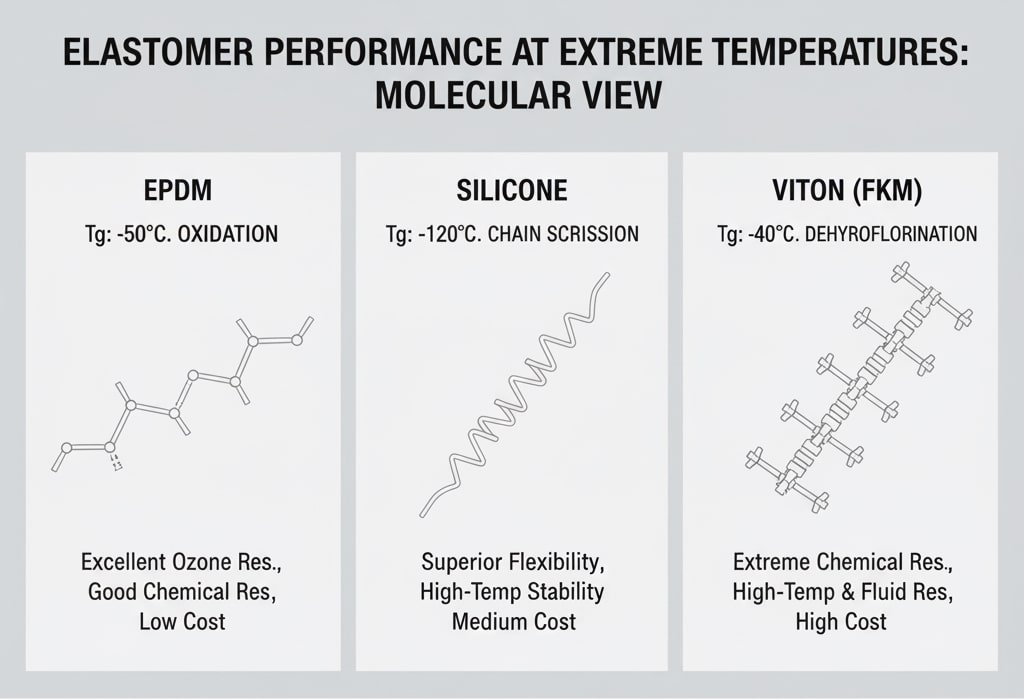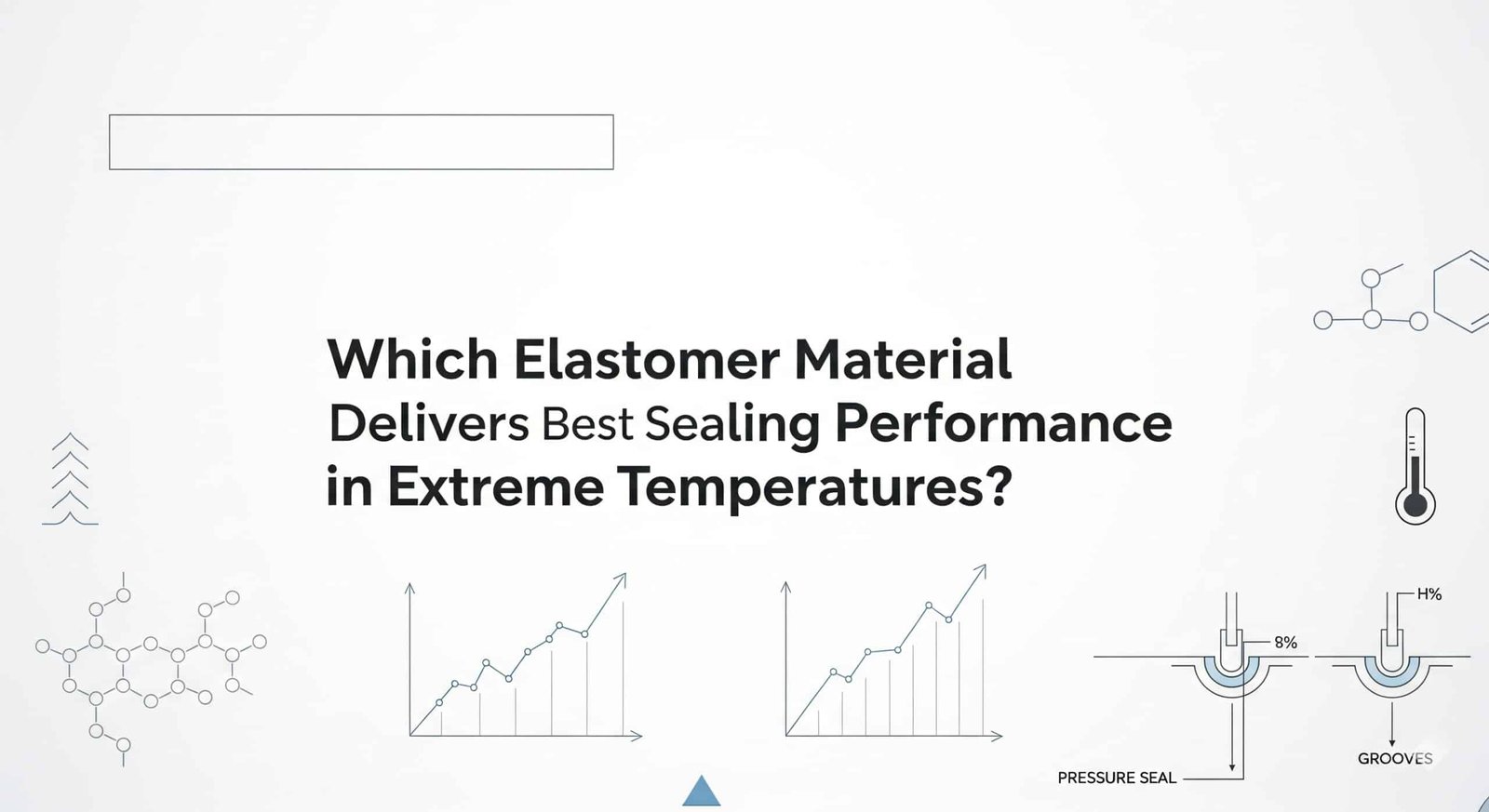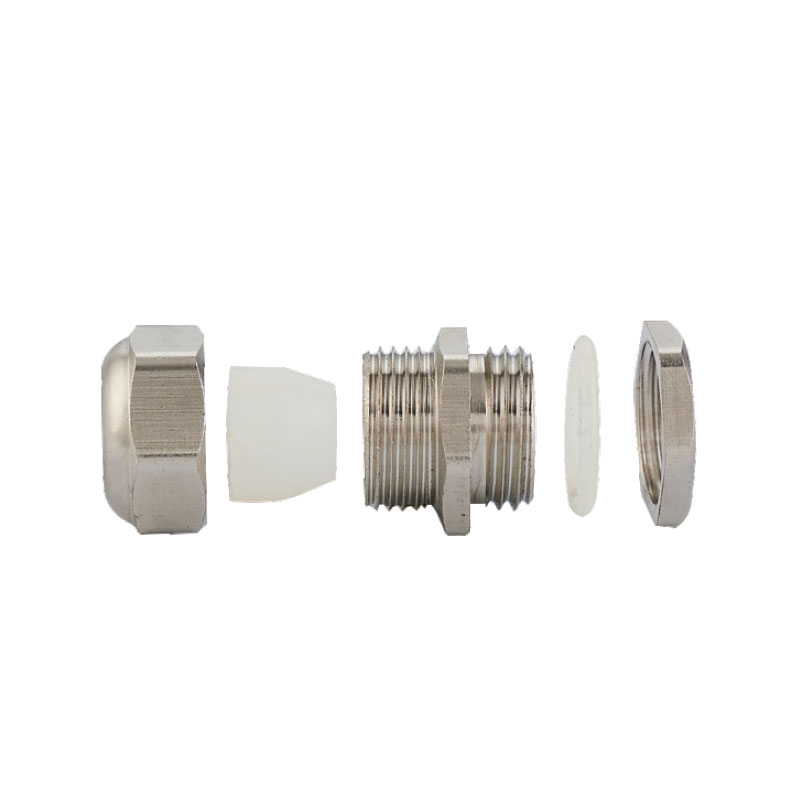
소개
Temperature extremes can destroy even the most robust cable gland installations, turning reliable sealing systems into costly failure points. The wrong elastomer choice means compromised IP 등급1, moisture ingress, and potential equipment damage worth thousands of dollars.
Viton(FKM) 엘라스토머는 극한 온도(-40°C ~ +200°C)에서도 EPDM(-50°C ~ +150°C) 및 실리콘(-60°C ~ +200°C) 대비 우수한 성능을 제공하며, 까다로운 산업 분야에 적합한 최고의 내화학성과 장기적인 안정성을 제공합니다.
After a decade in the cable connector industry, I’ve witnessed countless sealing failures that could have been prevented with proper elastomer selection. Understanding the science behind these materials isn’t just technical knowledge—it’s the difference between reliable operation and catastrophic system failure.
목차
- What Makes Elastomers Perform Differently at Extreme Temperatures?
- How Does EPDM Handle Temperature Extremes?
- Why Choose Silicone for High-Temperature Applications?
- When Is Viton the Best Choice for Extreme Conditions?
- How to Select the Right Elastomer for Your Application?
- FAQs About Elastomer Sealing Performance
What Makes Elastomers Perform Differently at Extreme Temperatures?
Understanding the molecular science behind elastomer behavior is crucial for making informed sealing decisions.
Elastomer performance at extreme temperatures depends on polymer chain flexibility, cross-linking density, filler materials, and molecular structure, with each material exhibiting unique glass transition temperatures and thermal degradation points that directly impact sealing effectiveness.

The Science Behind Temperature Performance
The fundamental difference between elastomer materials lies in their molecular architecture. Here’s what really determines performance:
Glass Transition Temperature (Tg)2: This critical point determines when an elastomer becomes brittle. EPDM has a Tg around -50°C, silicone around -120°C, and Viton around -20°C to -40°C depending on the grade.
Polymer Chain Structure: Linear polymer chains in silicone provide excellent flexibility at low temperatures, while the fluorinated backbone in Viton offers exceptional chemical and thermal stability.
Cross-Link Density: Higher cross-linking improves temperature resistance but reduces flexibility. Our engineering team at Bepto carefully balances these properties based on application requirements.
Thermal Degradation Mechanisms: Each material fails differently—EPDM through oxidation, silicone through chain scission, and Viton through dehydrofluorination at extreme temperatures.
성능 비교 매트릭스
| 속성 | EPDM | 실리콘 | Viton (FKM) |
|---|---|---|---|
| 온도 범위 | -50°C ~ +150°C | -60°C ~ +200°C | -40°C ~ +200°C |
| 내화학성 | Good | 공정 | 우수 |
| Ozone Resistance | 우수 | 우수 | 우수 |
| 압축 세트 | Good | 공정 | 우수 |
| 비용 요소 | 낮음 | Medium | 높음 |
How Does EPDM Handle Temperature Extremes?
EPDM remains the workhorse of industrial sealing applications, but understanding its limitations is crucial.
EPDM elastomers excel in low-temperature applications down to -50°C and offer reliable performance up to +150°C, making them ideal for standard industrial cable glands where chemical exposure is minimal and cost-effectiveness is prioritized.
Real-World EPDM Performance
Last winter, I worked with Michael, a facilities manager at a wind farm in North Dakota, USA. His outdoor electrical installations were experiencing seal failures during extreme cold snaps reaching -45°C. The existing silicone seals were becoming brittle and losing their sealing properties.
EPDM Advantages:
- Excellent low-temperature flexibility down to -50°C
- Outstanding ozone and weather resistance
- Cost-effective for large-scale installations
- Good electrical insulation properties
- Excellent water and steam resistance
EPDM Limitations:
- Limited chemical resistance to oils and fuels
- Temperature ceiling of +150°C
- Poor resistance to 방향족 탄화수소3
- Moderate compression set resistance
EPDM Grade Selection
Different EPDM formulations offer varying performance characteristics:
Standard EPDM (70 Shore A): General-purpose applications, -40°C to +120°C
Cold-Resistant EPDM (60 Shore A): Enhanced low-temperature flexibility, -50°C to +100°C
High-Temperature EPDM (80 Shore A): Improved thermal stability, -30°C to +150°C
For Michael’s wind farm project, we specified cold-resistant EPDM seals with enhanced low-temperature formulation. The installation has been running flawlessly for two years through multiple harsh winter cycles.
Why Choose Silicone for High-Temperature Applications?
Silicone elastomers offer unique properties that make them indispensable in specific high-temperature scenarios.
Silicone elastomers provide exceptional temperature range performance from -60°C to +200°C with outstanding flexibility retention, making them ideal for applications requiring consistent sealing across extreme temperature cycling, though chemical resistance limitations must be considered.
Silicone’s Unique Properties
그리고 siloxane backbone4 gives silicone elastomers their distinctive characteristics:
온도 안정성: Silicone maintains flexibility across the widest temperature range of common elastomers. The Si-O backbone is inherently stable and resists thermal degradation.
Flexibility Retention: Unlike other elastomers that become rigid at low temperatures, silicone maintains its sealing properties down to -60°C.
Biocompatibility: FDA-approved grades make silicone suitable for food processing and pharmaceutical applications.
전기적 속성: Excellent dielectric strength and arc resistance make silicone ideal for electrical applications.
애플리케이션별 고려 사항
식품 가공 산업: Platinum-cured silicone meets FDA requirements and handles steam sterilization cycles.
자동차 애플리케이션: High-temperature engine compartment sealing where flexibility across temperature cycles is critical.
의료 장비: Biocompatible grades for sterilizable medical device sealing.
항공우주: Extreme temperature cycling in aircraft and satellite applications.
However, silicone’s limitations include poor tear resistance, limited chemical compatibility with fuels and oils, and higher permeability compared to other elastomers.
When Is Viton the Best Choice for Extreme Conditions?
Viton represents the premium choice for the most demanding sealing applications.
Viton (FKM) elastomers deliver unmatched chemical resistance combined with excellent high-temperature performance up to +200°C, making them essential for petrochemical, aerospace, and aggressive chemical environments where seal failure is not an option.
The Viton Advantage
I remember working with Ahmed, who manages a petrochemical facility in Jubail, Saudi Arabia. His plant processes aggressive chemicals at temperatures reaching +180°C, and standard elastomers were failing within months. The cost of unplanned shutdowns far exceeded the premium price of Viton seals.
Viton’s Superior Properties:
- Exceptional chemical resistance to acids, fuels, and solvents
- Outstanding high-temperature stability up to +200°C
- Excellent compression set resistance
- Low permeability to gases and vapors
- Superior aging characteristics
Viton Grade Selection:
Viton A (Vinylidene Fluoride/Hexafluoropropylene):
- General-purpose grade
- Temperature range: -15°C to +200°C
- 우수한 내화학성
Viton B (Higher Fluorine Content):
- Enhanced chemical resistance
- Better fuel and solvent resistance
- Temperature range: -20°C to +200°C
Viton GLT (Low-Temperature Grade):
- Improved low-temperature flexibility
- Temperature range: -40°C to +200°C
- Maintains sealing at lower temperatures
Viton GFLT (Extreme Low-Temperature):
- Specialized low-temperature performance
- Temperature range: -45°C to +200°C
- Premium grade for extreme conditions
Ahmed’s facility has been using our Viton B cable gland seals for four years without a single failure, despite the harsh chemical environment and high operating temperatures.
How to Select the Right Elastomer for Your Application?
Choosing the optimal elastomer requires systematic evaluation of multiple performance factors.
Elastomer selection should prioritize the most critical performance requirement—whether temperature range, chemical compatibility, or cost-effectiveness—while ensuring all minimum requirements are met through comprehensive application analysis and long-term performance modeling.
선택 결정 매트릭스
Step 1: Define Critical Requirements
- Operating temperature range (continuous and peak)
- Chemical exposure types and concentrations
- Pressure requirements and cycling
- Expected service life
- 규정 준수 요구 사항
Step 2: Eliminate Unsuitable Options
- Rule out materials that cannot meet minimum requirements
- Consider safety factors for critical applications
- Evaluate long-term aging characteristics
Step 3: Economic Analysis
- 초기 재료비
- 설치 복잡성
- Maintenance frequency
- Failure consequences and downtime costs
- Total cost of ownership over service life
애플리케이션별 권장 사항
| 애플리케이션 유형 | 기본 선택 | 대안 | 주요 고려 사항 |
|---|---|---|---|
| 표준 산업 | EPDM | 실리콘 | Cost vs. performance balance |
| High-Temperature Process | 실리콘 | Viton | 화학물질 호환성 확인 |
| 화학 처리 | Viton | FFKM | Specific chemical resistance |
| 식품/의약품 | Silicone (FDA) | EPDM (FDA) | 규정 준수 |
| 항공우주/방위산업 | Viton GLT | 실리콘 | 극한의 온도 사이클링 |
| 해양/해양 | EPDM | Viton | Saltwater and hydrocarbon exposure |
Performance Optimization Tips
Compound Selection: Work with suppliers to optimize durometer, cure system, and additives for your specific application.
디자인 고려 사항: Proper groove design and compression ratios are critical for optimal seal performance regardless of material choice.
품질 보증: Specify appropriate testing standards (ASTM D3955 for compression set, ASTM D412 for tensile properties) to ensure consistent quality.
At Bepto, we maintain extensive application databases and can provide specific recommendations based on your exact operating conditions and performance requirements.
결론
Understanding elastomer science is crucial for reliable sealing performance in extreme temperature applications. While EPDM offers cost-effective solutions for standard industrial conditions, silicone excels in wide temperature range applications, and Viton provides unmatched performance in aggressive chemical environments. The key is matching material properties to your specific requirements while considering total cost of ownership. Our team at Bepto combines deep technical knowledge with practical application experience to help you select the optimal elastomer solution for your cable gland sealing needs. Remember, the right elastomer choice today prevents costly failures tomorrow! 😉
FAQs About Elastomer Sealing Performance
Q: How do I know if my current elastomer seals are failing due to temperature?
A: Look for hardening, cracking, or permanent deformation of the seal material. Temperature-related failures typically show brittle fractures at low temperatures or permanent compression set at high temperatures, often accompanied by loss of IP rating.
Q: Can I use silicone seals in applications with petroleum products?
A: Generally no, silicone has poor resistance to petroleum products and will swell significantly. Use Viton or specialized EPDM compounds for fuel and oil exposure applications to maintain proper sealing performance.
Q: What’s the difference between Viton and generic FKM elastomers?
A: Viton is Chemours’ premium FKM brand with consistent quality and extensive technical support. Generic FKM may offer cost savings but can vary in quality and performance consistency, making Viton preferred for critical applications.
Q: How does compression set affect long-term sealing performance?
A: Compression set measures permanent deformation under load. High compression set means the seal won’t return to original shape, losing contact pressure and sealing effectiveness. Viton typically shows the lowest compression set, followed by EPDM, then silicone.
Q: Should I consider FFKM for extreme chemical applications?
A: FFKM (perfluoroelastomer) offers superior chemical resistance compared to Viton but at significantly higher cost. Consider FFKM when Viton cannot provide adequate chemical resistance or when zero-failure tolerance justifies the premium investment.
-
방진 및 방습에 대한 다양한 IP(Ingress Protection) 등급을 설명하는 자세한 차트를 참조하세요. ↩
-
Understand the science behind the Glass Transition Temperature (Tg) and why it’s a critical property for predicting elastomer low-temperature performance. ↩
-
Review a list of common aromatic hydrocarbons and understand their chemical structure to better assess material compatibility. ↩
-
Explore the unique chemical structure of the siloxane (silicon-oxygen) backbone and learn why it gives silicone its wide temperature stability. ↩
-
Read the official summary and scope of the ASTM D395 standard, the primary test method for measuring the compression set properties of elastomers. ↩



